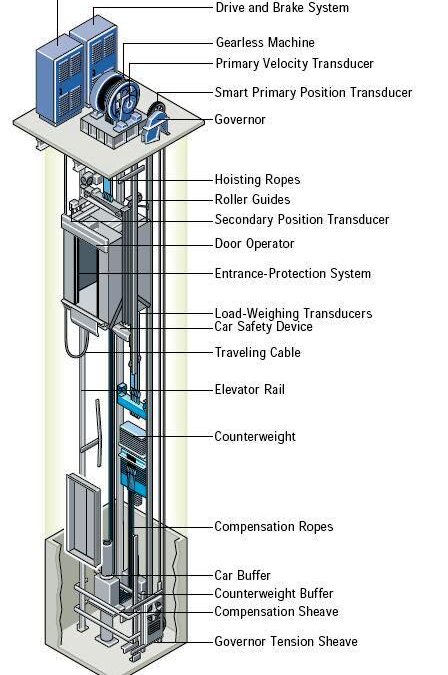Lifts and elevators have become indispensable in Nigeria’s commercial and residential buildings. From high-rise apartments to office complexes and shopping malls, these vertical transportation systems play a crucial role in improving accessibility and convenience. However, due to factors like poor maintenance, erratic power supply, and aging infrastructure, elevators in Nigeria frequently encounter operational issues. In this article, we will explore the most common problems with lifts and elevators in Nigeria and how to fix them effectively.
1. Frequent Power Failures
One of the biggest challenges facing elevators in Nigeria is the frequent and unpredictable power outages. The country’s power grid is often unreliable, causing disruptions in elevator operations and potentially trapping passengers inside.
Solution:
- Backup Power Systems: Installing an Uninterruptible Power Supply (UPS) or a dedicated generator can ensure that elevators continue functioning during power failures.
- Automatic Rescue Devices (ARD): ARDs enable elevators to safely transport passengers to the nearest floor and open doors in case of power failure.
- Regular Maintenance: Ensure the elevator’s power system is checked regularly for faults and to confirm that the backup power solutions are functional.
2. Poor Maintenance Practices
Many elevators in Nigeria suffer from poor maintenance, leading to frequent breakdowns, malfunctions, and safety hazards. Lack of proper servicing can cause minor issues to escalate into major failures.
Solution:
- Routine Inspections: Elevators should be inspected at least once a month by a certified technician to check for worn-out parts, lubrication issues, and electrical faults.
- Qualified Technicians: Ensure that maintenance is carried out by trained professionals rather than unqualified personnel.
- Preventive Maintenance: Property managers should implement a preventive maintenance schedule instead of waiting for faults to occur.
3. Overloading
Elevator overloading is a common issue in Nigeria, especially in commercial buildings with high foot traffic. Exceeding the weight limit can lead to mechanical strain, system breakdown, or even sudden halts.
Solution:
- Clear Weight Limit Indicators: Ensure that weight limit signs are visible to all users.
- Load Sensors: Modern elevators come with load sensors that prevent operation when overloaded.
- User Awareness: Educate users on the dangers of overloading through notices and announcements.
4. Faulty Door Mechanisms
Elevator doors that fail to open or close properly can cause delays, inconvenience, and safety risks. This issue is often caused by dirt accumulation, misalignment, or electrical failures.
Solution:
- Regular Cleaning: Dust and debris should be cleaned from door tracks frequently.
- Sensor Checks: Door sensors should be tested regularly to ensure they detect obstructions correctly.
- Mechanical Adjustments: If doors frequently get stuck, a technician should adjust the alignment and lubrication of the moving parts.

5. Unusual Noises and Vibrations
If an elevator produces excessive noise or vibrations while in operation, it could indicate worn-out components, misalignment, or lack of lubrication.
Solution:
- Lubrication: Ensure that all moving parts, such as pulleys and cables, are well-lubricated.
- Component Replacement: If noise persists, worn-out parts like bearings, guide rails, or motor components should be replaced.
- Regular Inspections: A scheduled maintenance routine should be implemented to catch these issues early.
6. Elevator Jerks and Sudden Stops
Jerking movements or abrupt stops during an elevator ride can be frightening for passengers and may indicate a serious underlying issue.
Solution:
- Check the Braking System: Faulty brakes should be inspected and replaced by a professional technician.
- Recalibration of Elevator Control System: Elevators should be recalibrated to ensure smooth stopping and starting.
- Hydraulic Fluid Maintenance: If it’s a hydraulic elevator, the fluid level should be checked and refilled as needed.
7. Poor Ventilation and Overheating
Elevator cabins with poor ventilation can become extremely hot, especially in Nigeria’s warm climate. This can cause discomfort to passengers and affect electronic components.
Solution:
- Install Ventilation Systems: Ensure that the elevator cabin has adequate ventilation fans.
- Routine Electrical Checks: Overheating may be caused by electrical faults, which should be addressed during maintenance.
- Emergency Ventilation: Modern elevators are equipped with emergency ventilation systems that should be tested periodically.
8. Outdated Elevator Systems
Many buildings in Nigeria still use old and outdated elevator systems that lack modern safety features. These systems are prone to breakdowns and pose serious risks to users.
Solution:
- Modernization: Consider upgrading older elevators with modern control systems, safety features, and energy-efficient components.
- Compliance with Safety Regulations: Ensure that the elevator meets local and international safety standards.
- Professional Assessment: Have a technician evaluate whether the system needs a complete overhaul or minor upgrades.
Conclusion
Ensuring that lifts and elevators function efficiently in Nigeria requires a combination of proper maintenance, compliance with safety standards, and the use of modern technology. Property owners and facility managers must invest in high-quality installations, regular servicing, and backup power solutions to mitigate common elevator issues. By addressing these challenges proactively, we can improve safety, reliability, and overall user experience in vertical transportation across Nigeria.

